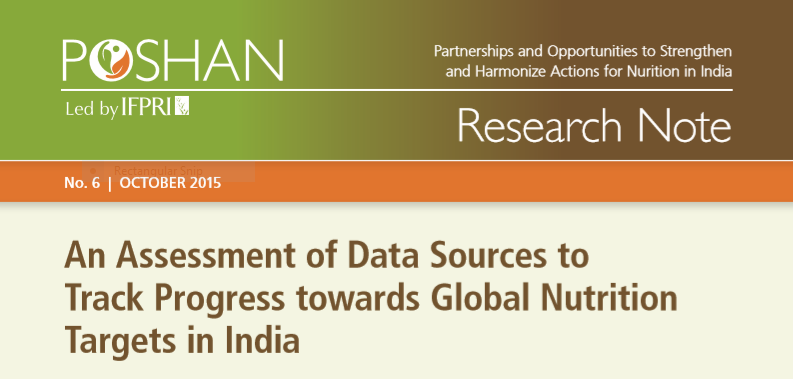 In 2014, a country nutrition profile for India was released along with the first ever Global Nutrition Report in November 2014. This year, as part of the lead up to the Sustainable Development Goals, the World Health Assembly (that India is also a part of) nutrition targets have also been in the news. And in India, three surveys that included nutrition indicators – the District Level Health Survey (2012-13), the Annual Health Survey (2013-14) and the Rapid Survey on Children (2013-14) were all released within the last year.
In 2014, a country nutrition profile for India was released along with the first ever Global Nutrition Report in November 2014. This year, as part of the lead up to the Sustainable Development Goals, the World Health Assembly (that India is also a part of) nutrition targets have also been in the news. And in India, three surveys that included nutrition indicators – the District Level Health Survey (2012-13), the Annual Health Survey (2013-14) and the Rapid Survey on Children (2013-14) were all released within the last year.
As we watched and participated in discussions and debates about progress on nutrition in India, we were struck by how challenging it was to make sense of which data sources could, in fact, be used to track the status of nutrition in India. With this in mind, we conducted an assessment of nutrition data sources. We shared preliminary findings from this initial assessment of at a stakeholder roundtable in New Delhi where the Global Nutrition Report 2014 was discussed. We are now pleased to release a research note on the final results from the assessment and provides recommendations that can help to strengthen data collection efforts to assess India’s progress toward achieving the World Health Assembly nutrition targets.
Here are some highlights of the data assessment:
- Only a few surveys have collected data on all six World Health Assembly nutrition targets
- Only a few surveys are administered in all states and districts of India and gaps in district-level estimates are the greatest
- The average time between each survey round ranges from one to nine years!
- Target respondent groups and indicator definitions vary quite a lot across the different surveys
- The availability of survey documentation, reports and raw data is quite variable
Based on our findings, we conclude that that for assessing trends in key nutrition indicators over the last decade, the NFHS-3 and RSOC 2014 are most comparable surveys. Looking forward, it is important to agree on the key parameters for surveys that include nutrition indicators so as to enable consistent, comparable and frequent data collection on all six World Health Assembly indicators. It is particularly important that a mechanism for more frequent data collection is ensured, that the same indicator definitions, reference age groups and target groups are used in all surveys, and that survey reports, questionnaires and raw data are released to the public domain rapidly and simultaneously.
Click here to access the Research Note


